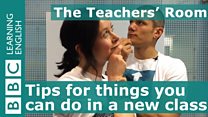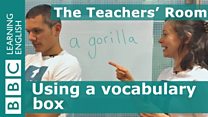Unit 8: English You Need
Exams, news, pronunciation, teachers' tips, learners' questions
Select a unit
- 1 English You Need
- 2 English You Need
- 3 English You Need
- 4 English You Need
- 5 English You Need
- 6 English You Need
- 7 English You Need
- 8 English You Need
- 9 English You Need
- 10 English You Need
- 11 English You Need
- 12 English You Need
- 13 English You Need
- 14 English You Need
- 15 English You Need
- 16 English You Need
- 17 English You Need
- 18 English You Need
- 19 English You Need
- 20 English You Need
- 21 English You Need
- 22 English You Need
- 23 English You Need
- 24 English You Need
- 25 English You Need
- 26 English You Need
- 27 English You Need
- 28 English You Need
- 29 English You Need
- 30 English You Need
Session 4
Welcome to The Teachers’ Room. The show all about teaching practice. Grab a cup of coffee, pull up an armchair and relax. Learn something new, remember something fundamental or just have a giggle.
Activity 1
The Teachers' Room
3 ways to make reading engaging
Dan and Sian discuss three ideas to make reading a bit more enjoyable for students
Watch the video and complete the activity

___________________________________________________________________
Did you like that? Why not try these?
____________________________________________________________________________________
3 ways to make reading engaging
Reading is an important skill. Many reading lessons progress in a similar fashion: Prediction, Gist, Detail and Language work. Here are some ideas to make things more interesting.
Prediction
Getting students to predict what they will read not only engages their interest but also allows them time to begin to associate with the context of the reading. Use images, headlines, paragraph headings and graphics to get learners discussing what they believe they will be reading. A few key words can also be given out. These can be done all at once, or one at a time, getting students to change their predictions with each successive word.
Gist
Gist activities allow students to gain a general understanding of a text without too much detail. Usual methods include getting them to verify their predictions or answering general true or false questions about the text. However, Sian recommends playing ‘screw up’. Take the chosen text and roll it into a ball. The students may not unroll the ball. Ask the students to get a general idea of the text by reading the outside layer.
Scanning
Scanning is a skill which teaches students to find key information rapidly without reading everything in the text. It is useful for texts like timetables, menus and leaflets. Playing ‘grass skirt’ is a good way to practice this skill. Prepare some questions on a relevant text and cut them into a grass skirt. Hang them on the wall – one per group. Ask students to race to retrieve a question, return to their group and scan the text to find the answer. The first group to finish wins.
To do
Try our quiz to see if you've picked up our tips.
The Teachers' Room Quiz
5 Questions
Check what you've learned by selecting the correct answer to each question.
Help
Activity
Check what you've learned by selecting the correct answer to each question.
Hint
Generally reading lessons tend to move from ambiguity to close language work - so from less information to more.Question 1 of 5
Help
Activity
Check what you've learned by selecting the correct answer to each question.
Hint
If we drip feed something, we only hand it out one at a time. Why would this be useful?Question 2 of 5
Help
Activity
Check what you've learned by selecting the correct answer to each question.
Hint
After a prediction stage, what have the students come up with?Question 3 of 5
Help
Activity
Check what you've learned by selecting the correct answer to each question.
Hint
'Screw up' is the game where we screw up a text for students to use as a gist reading activityQuestion 4 of 5
Help
Activity
Check what you've learned by selecting the correct answer to each question.
Hint
When you scan you do not read every word but are looking for one thingQuestion 5 of 5
Excellent! Great job! Bad luck! You scored:
Get involved
Well, those were just a few ideas that we here at BBC Learning English had, but we know that you teachers out there have lots of fantastic ideas too, and we’d like you to share them with us and everybody else.
If you have a great tip or technique for teaching reading, or anything else, please email us at learningenglish@bbc.co.uk. Your email could be posted here on this page, or may even be mentioned in our show.
We are also looking for video tips to include in the programme. In order to do this, please include whether or not you’d like to be included for video with your tip.
Ekaterina, Russia
After watching this new session "The Teacher's Room" I can't help trying to remember more and more useful and interesting class activities. So here are some more of them. I hope you find them entertaining.
1. You bring a bag to the classroom and ask your students to put one of their belongings into it (it can be some stationary, accessories or even boots :)) depending on what vocabulary you want to revise). Then you should have each student pick the thing that is not his/her own. Now they must mingle and ask: "Is it your ...?" and expect the answer like "Yes, it is mine" or "No, it is not mine" until they have their belongings back. Remember to mention what is not acceptable, like walking up to the student and saying "It's mine."
2. This activity helps to practice the spelling of new words, especially the objects in the classroom. Bring two post-its in two different colours, divide the class in two groups and assign each group with a colour. Now they have to label a certain amout of objects in the classroom (for example, furniture) using the correct article and spelling. (If the things you need are not present in the classroom, just bring them!) Limit their time. The team which has more CORRECT post-its wins!
Wow, Ekaterina. These are the fifth and sixth tips that you have sent us. It's wonderful that our programme has created this outflowing of ideas. Thank you so much for sharing them.
End of Session 4
Next up is Learners' Questions, our brand new series, where we choose one question sent in by an English language learner, and provide an answer. This time, Daniela from Italy wants to know how to use the phrase be likely to.
Session Vocabulary
3 ways to make reading engaging
- Use images, headlines and graphics to aid prediction
- Gist activity: Play 'screw up'
- Scanning activity: Play 'grass skirt'


